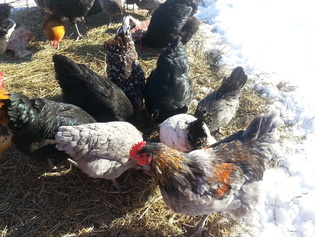
1. Chickens eat their weight in weeds and bugs when they are allowed to free range and forage. The benefits of pest control is quite considerable, reducing the need for chemical sprays and pesticides.
2. Chickens love left overs, so if a back yard urban dweller keeps 3 chickens, all of the left over food can be given to them, provided it is not mouldy or rotting. This would considerably reduce landfill waste and the costs associated with it.
3. Chickens are omnivores, that is, they eat everything, including meat. When we think of the farmer scattering a handful of grain for the birds, most of us think that is all they eat. Certain breeds of chickens will keep the mice population at bay as well as the flies and mosquitos.
4. Chickens do eat grain and wheat is their favourite, but it is not a balanced diet to only feed them grain. That would be like us eating nothing but bread. We could survive, however, in time, we would become malnourished and deficient in key nutrients, as will chickens.
5. They need a source of calcium and of grit. Dirt, sand and light gravel will all work for grit, but it can be bought as well, which is especially good in areas where they cannot peck through the snow to get the dirt/sand. The grit is used in the gizzard to grind the whole grains before entering the digestive tract. Egg shells can be fed back to them, dried and ground, though the amount of calcium would still be inadequate. The most common source is oyster shells, a byproduct of the fishing industry.
6. Roosters are not necessary for a hen to lay eggs. The only reason a rooster would be kept is if chicks are desired, though, when a hen sits on a nest for approximately 21 days, she is not laying eggs or foraging for bugs.
7. Some breeds are flighty and not well suited to backyard chicken keeping. The most active foragers also tend to be the breeds that do not like to be picked up and caressed or even have any human contact. Some breeds do not tolerate rain and others do not survive extreme cold winters without a heat source in their coop. Choose wisely for your area and expectations.
8. Certain breeds are better layers than others. If you keep chickens for the eggs, choose the best laying hens for your climate conditions. Research. Remember, what goes into the chickens also goes into the eggs. Commercial feed is mainly comprised of genetically modified grains, plus minerals and a protein source, these days canola meal being the most common. The eggs the hen produces will only be as good as what she is fed. Opt for organic feed or create a diet similar to your own for your birds.
9. What happens when the chickens are not laying anymore? Do you eat them? How will you dispose of them?
10. There is a great deal of conflicting information in books and online regarding raising chickens and even controversy regarding the breed standards. Many people raise chickens as a hobby and some do not have good standards. Chickens kept in poorly designed coops and who do not have room to run are prone to mites, lice, worms and other horrible inconveniences. Always buy chickens from a reputable breeder and visit the coops to see if they are clean and sanitary and the chickens are well and happy.
The birds at The Fat Ewe Farm are partners in our agriculture. They do provide pest control in the summer and are worth their weight in gold for the amount of ants they consume, something that was a problem in previous years. The eggs are a by product. We do not sell them, but have given them away quite often. Otherwise the dogs get scrambled eggs, shell and all, and sometimes the pigs and even the chickens also eat the cooked eggs. Excess chickens have been sent to the processor for stew, though raising them for meat is not the reason they are on the farm. What does one do when the mamma hen broods a dozen chicks and most of them are roosters? So, the dilemma continues regarding not raising animals to eat them, but what to do when there are too many? It is the proverbial question of the chicken and the egg in another form. At any rate, chickens, whether you have just three on a city lot or a whole lot on a farm, are a valuable part of a farm and play an important role in mixed farming.

 RSS Feed
RSS Feed